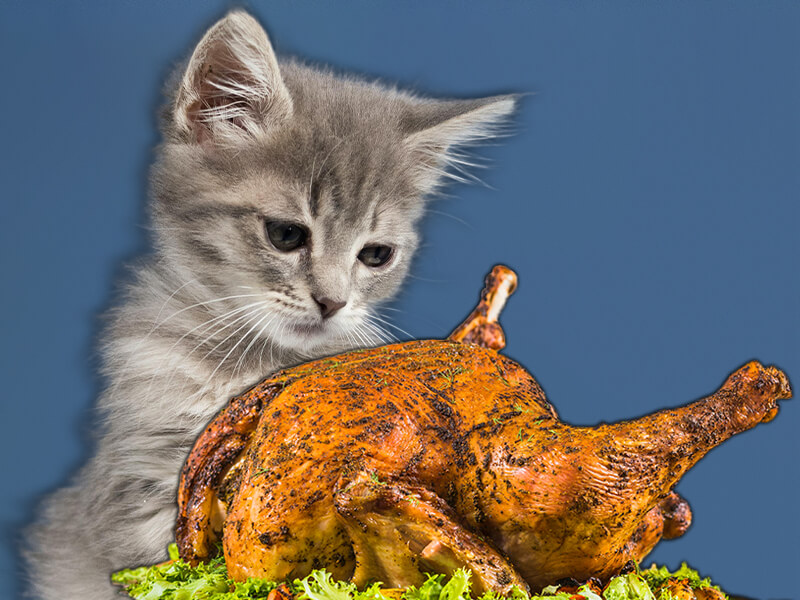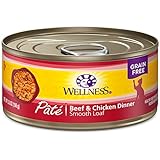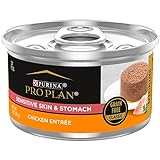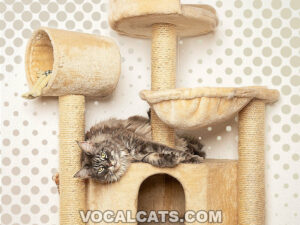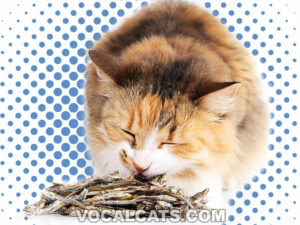Can Cats Eat Chicken Skin? Yes, cats can eat Chicken Skin as long as it’s cooked. Chicken Skin is high in protein and fats. That means it can contribute to your pet’s caloric intake healthily. However, it may not be suitable for felines with obesity, pancreatitis, and other health concerns.
Cat parents often ask if feeding their felines Chicken Skin is safe. If you’ve similar queries, then our cat-centric guide can help. This article will focus on all aspects of giving cats Chicken Skin, including benefits, possible dangers, and other details.
Just like chicken bones aren’t safe for cats unless you plan to give your pet plain broth, there are ways to feed your fur baby Chicken Skin. That’s where we can help. Stay with us as we explain how, when, and why you can utilize Chicken Skin for a healthy treat for your pet!
Contents
- Can Cats Have Chicken Skin?
- Do Cats Eat Chicken Skin?
- Is Chicken Skin Bad For Cats?
- Is Chicken Skin Good For Cats?
- Can kittens Eat Chicken Skin?
- How To Cook Chicken Skin For Cats?
- Chicken Skin For Cats
- Can Cats Eat Boiled Chicken Skin?
- Can Cats Eat Cooked Chicken Skin?
- Can Cats Eat Fried Chicken Skin?
- Can Cats Eat Raw Chicken Skin?
- Can Cats Eat Rotisserie Chicken Skin?
- What Human Food Can Cats Eat?
- Alternatives to Chicken Skin For Cats
- So, Can Cats Eat Chicken Skin?
- Related Questions
Can Cats Have Chicken Skin?

If you take certain precautions, there’s no harm in feeding your cat cooked or boiled Chicken Skin. On its own, Chicken Skin is high in moisture content, energy, protein, and fats. If the skin is prepared right and fed to felines occasionally, it positively affects your pet’s health.
However, there are a few caveats attached to this food item. If you’re feeling a little confused, don’t stress. We’ve compiled data about how many nutrients 100 grams of Chicken Skin contains and how it can affect your fur baby.
Nutritional Profile of Chicken Skin (100 grams)
| Name, Unit | Amount |
| Calories, cal | 450 |
| Sodium, mg | 387 |
| Total Fat, g | 40.34 |
| Water, g | 39.96 |
| Potassium, mg | 135 |
| Phosphorus, mg | 124 |
| Protein, g | 20.19 |
| Selenium, µg | 19.8 |
As you can see, 100 grams of Chicken Skin is high in fat and sodium. That makes it unsuitable as a regular food item or a treat for felines with pancreatitis or kidney problems.
Experts generally advise specially formulated pet food in such cases, such as the Wellness Complete Health Grain Free Cat Food.
Conversely, the skin contains sizable amounts of moisture, vitamins, and minerals, meaning it can benefit felines without certain underlying health issues. That’s why your vet’s input is invaluable because they can guide you to what’s best for your pet according to its specifics.
Do Cats Eat Chicken Skin?
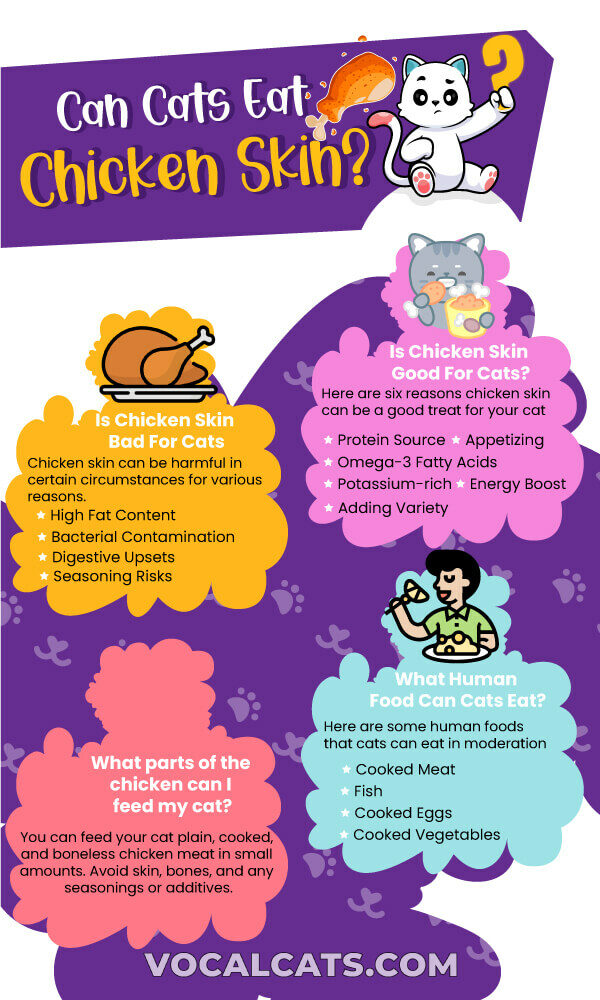
Cats like eating Chicken Skin. Felines are obligate carnivores, so don’t be surprised if you catch your cat making off with raw Chicken Skin to nibble on. But feeding your pets uncooked skin or meat should be avoided.
While felines in the wild are used to consuming raw meat, domesticated cats aren’t, making them especially susceptible to bacteria in uncooked meat.
The best way to feed your feline a once-in-a-blue-moon treat of Chicken Skin is to boil or pan-fry it. Doing so will make the skin softer, allowing your cat to chew and digest it easily.
Another aspect to remember when dealing with Chicken Skin is that it’s unsuitable for cats with sensitive tummies, pancreatitis, and other health concerns.
If you want to be sure whether Chicken Skin will suit your feline, it’s best to consult your veterinarian. There’s also more on this topic below.
DON’T MISS: Can Cats Eat Canned Chicken?
Is Chicken Skin Bad For Cats?

While Chicken Skin is generally considered safe for felines to consume, it can be harmful in certain circumstances for various reasons. Here’s what a few of them are:
1. High Fat Content
Chicken Skin is rich in fat, which can be problematic when consumed excessively. Cats are obligate carnivores, and though they need a reasonable amount of fat in their diet, too much fat can lead to obesity, pancreatitis, and digestive issues. Feeding your cat Chicken Skin if it is already obese or has pancreatitis can be harmful.
2. Bacterial Contamination
Raw or undercooked Chicken Skin poses the risk of bacterial contamination, particularly salmonella, and Campylobacter. These bacteria can cause serious foodborne infections in both cats and humans. Cooking the Chicken Skin is essential to eliminate this risk.
3. Digestive Upsets
The high-fat content in Chicken Skin can cause digestive upset in cats, especially if they have sensitive stomachs. Cats may experience diarrhea, vomiting, or other gastrointestinal issues when they consume fatty foods like Chicken Skin.
4. Seasoning Risks
When feeding your pet Chicken Skin, it’s essential to ensure it is plain and unseasoned. Seasonings like salt, garlic, onions, or spices commonly used in human cooking can be toxic to cats. If the Chicken Skin is seasoned, it can pose a risk to your pet’s health.
5. Balanced Diet Concerns
Offering small amounts of Chicken Skin as an occasional treat is okay, but it’s crucial to remember that a cat’s primary diet should consist of high-quality commercial cat food.
Cat food is formulated to meet your fur baby’s unique nutritional requirements, including essential vitamins and minerals.
For example, Wellness Complete Health Grain Free Cat Food is packed full of proteins, vitamins, minerals, and essential fatty acids for a complete, well-balanced nutrition.
Feeding your cat too much Chicken Skin or other human foods can lead to dietary imbalances and deficiencies over time.
Is Chicken Skin Good For Cats?
Experts advise feeding felines Chicken Skin in moderation and as part of an overall balanced diet. Here are six reasons Chicken Skin can be a good treat for your furry pet:
1. Protein Source
Chicken Skin is rich in protein, an essential aspect of the feline diet. Protein helps maintain muscle mass, supports growth in kittens, and ensures overall health. Including Chicken Skin as an occasional treat can increase their protein intake.
2. Omega-3 Fatty Acids
Since Chicken Skin is fat-rich, it offers the benefit of Omega-3 Fatty Acids. Omega-3 is great for feline skin and coat health, especially if your pet has dry skin problems. Increasing the intake of these fatty acids can lead to a healthier coat and reduce concerns like itchiness.
3. Potassium-rich
As an electrolyte, potassium helps function nerves and muscles and promotes heart health. It’s helpful when cats are lethargic after recovering from an illness.
4. Energy Boost
The fat content in Chicken Skin can double as an energy boost for your fur baby. Consequently, giving your pet such treats in moderation when recovering from surgery can help it regain strength quickly.
5. Appetizing
Felines can be picky eaters sometimes. If your pet is fussy about food, offering Chicken Skin as the occasional snack can tempt them to eat well. Snacks like Chicken Skin can also be used to mask the taste of medications.
6. Adding Variety
If you’re looking for a healthy option to add variety to your feline’s diet, plain cooked Chicken Skin can help. Since most cats love the taste of Chicken Skin, they’ll take to the snack in no time. It’s a good way to show your pet some love.
READ NEXT: Can Cats Eat Chicken Noodle Soup?
Can kittens Eat Chicken Skin?
Kittens beyond four months of age can eat cooked or boiled Chicken Skin in moderation. Being high in protein, fats, and electrolytes like potassium, Chicken Skin can be a healthy snack for your young fur baby once in a while.
However, before you feed your kitten Chicken Skin, be sure to take note of the following precautions.
Vet Input
Whether or not your feline will benefit from consuming Chicken Skin can depend on factors like age, health, immunity, etc. Consulting your vet before making additions to your fur baby’s diet will help you understand your pet’s nutrition and dietary needs.
For example, your vet may advise you to ensure your pet doesn’t eat anything raw because kittens are particularly susceptible to infections until they complete their vaccinations and develop immunity at one year of age.
Portion Control
Kittens are smaller in size than adult felines, meaning they have smaller stomachs. As such, you’ll need to be careful about portion control and not overfeed your kitten a decadent treat like Chicken Skin. Doing so can lead to stomach upsets.
Cooking the Skin
Ensure the item is well-cooked and bite-sized when feeding a kitten Chicken Skin. Raw meat risks bacterial contamination, and skin that isn’t bite-sized can pose choking hazards.
Avoid All Seasonings
It’s essential to give your kitten plain and well-cooked Chicken Skin. Seasonings like garlic or onion are toxic to felines, among others.
RELATED: Can Cats Eat Chicken Nuggets?
How To Cook Chicken Skin For Cats?
Cooking Chicken Skin for cats should be done with care to ensure it’s safe and nutritious for your feline friend. Here’s a simple step-by-step guide on how to prepare Chicken Skin for your cat:
1. Choose High-Quality Chicken
Start with a high-quality chicken source. Avoid using chicken close to its use-by date or sitting in the refrigerator for too long.
2. Remove Bones and Excess Fat
The next step involves carefully removing bones or excess fat from the Chicken Skin. Chicken bones are brittle and should be avoided because they can lead to internal damage when ingested. On the other hand, excess fat can lead to stomach upsets, especially when you’re trying out the treat for the first time.
3. Cook Thoroughly
Selecting how to cook Chicken Skin is easy enough. Pet parents have two options: boiling or baking. You can also cook the skin in a frying pan without adding an oil source. The fat in the Chicken Skin is enough to cook the meat.
4. No Seasonings
When cooking the Chicken Skin, do not season the Chicken Skin with salt, garlic, onions, or other spices. Cats have sensitive digestive systems, and some seasonings can be toxic. Additionally, Chicken Skin is high in sodium and doesn’t require salt.
5. Cut into Bite-size Portions
After cooking, allow the Chicken Skin to cool and cut it into small, bite-sized pieces. Doing so makes it easier for your cat to digest and reduces the risk of choking.
6. Observe Your Cat
Pay attention to how your cat reacts to the Chicken Skin after feeding it the first few times. Some pets have sensitivities or allergies to chicken, so monitor them for reactions like vomiting or diarrhea.
Chicken Skin For Cats
If you’ve been searching high and low for details on ‘Chicken Skin Cats,’ we’ve got you covered. Whether you’re looking for info on what’s the best way to cook Chicken Skin or the pros and cons of raw Chicken Skin, scroll down to learn more.
Can Cats Eat Boiled Chicken Skin?
Yes, cats can eat boiled Chicken Skin now and then as treats. Boiling Chicken Skin makes it safer for feline consumption by reducing the risk of harmful bacteria like E. Coli. It provides a protein-rich and fatty snack that many cats find delicious.
When preparing boiled Chicken Skin for cats, make sure it’s plain, without any seasonings, salt, or additives. Remove any bones and excess fat to avoid digestive issues or choking hazards.
It’s also important to cut the skin into small, manageable pieces for your cat to enjoy safely. Note that while some cats tolerate Chicken Skin well, others may have sensitivities or allergies, so monitor your fur baby’s reactions closely.
Can Cats Eat Cooked Chicken Skin?
Felines can eat cooked Chicken Skin sparingly. It provides them with a source of protein and healthy fats. However, feeding your cat plain cooked Chicken Skin without bones, excess fat, or seasonings is vital.
Bones and excess fat can lead to digestive issues and choking hazards. It’s also important to ask your vet whether cooked Chicken Skin will make a good treat for your pet according to its specifics.
Can Cats Eat Fried Chicken Skin?
Feeding your pet fried Chicken Skin isn’t a good idea. Chicken Skin is pretty high in fats on its own, and frying it can make it heavier for your cat’s digestive system. Ready-made fried Chicken Skin includes excessive oil, seasonings, and sodium, which are bad for a feline’s health.
Can Cats Eat Raw Chicken Skin?
Can cats eat Chicken Skin raw? Nope. Feeding your feline raw Chicken Skin is not recommended due to various health concerns. First, raw Chicken Skin carries a significant risk of bacterial contamination, primarily from Salmonella and Campylobacter.
These microorganisms can cause serious gastrointestinal infections in cats, leading to diarrhea, vomiting, and general discomfort. Similarly, raw Chicken Skin may contain harmful parasites, such as Toxoplasma Gondii, which can infect felines and pose health risks to the cat and its human caregivers.
Cooking Chicken Skin can help eliminate these dangers by killing bacteria and parasites, making it safer for consumption. It’s vital to always prioritize the safety and well-being of your cat by avoiding raw Chicken Skin and opting for cooked alternatives as an occasional snack.
Can Cats Eat Rotisserie Chicken Skin?
While cats like eating rotisserie Chicken Skin, you should avoid feeding it to your cats. Rotisserie Chicken Skin is typically flavorful and includes seasonings that can be harmful to your feline. The excess fat and sodium content in rotisserie chicken aren’t good for your pets.
What Human Food Can Cats Eat?
Cats have specific dietary requirements, and while occasional small servings of certain human foods are safe, it’s essential to be cautious. Here are some human foods that cats can eat in moderation:
Cooked Meat: Plain, cooked meats like chicken, turkey, or lean beef are generally safe for cats. Ensure there are no seasonings, sauces, or bones which can be harmful.
Fish: Occasional cooked fish like salmon or tuna can be a treat but not a primary source of nutrition. Avoid feeding your fur baby raw fish due to potential parasites.
Cooked Eggs: Scrambled or boiled eggs are protein-rich and safe for cats when cooked thoroughly. However, referring to your vet before adding something new to your cat’s diet is best.
Cooked Vegetables: Cats can nibble on cooked vegetables like peas, carrots, or broccoli, but these should be a small part of their diet
Remember to always introduce new foods to your pet’s diet gradually and watch for adverse reactions. Moreover, well-balanced commercial cat food is essential for meeting your cat’s nutritional needs.
Avoid feeding cats chocolate, caffeine, alcohol, onions, garlic, grapes, raisins, and foods high in salt, as these can be toxic to felines.
Alternatives to Chicken Skin For Cats
If you’re looking for alternatives to Chicken Skin for your cat, here are a few options to consider.
- Lean Cooked Meats: Offer small amounts of cooked lean meats like turkey or chicken free from seasonings, sauces, and bones.
- Fish: Occasional cooked fish such as salmon or tuna can be a tasty alternative, but avoid excessive consumption due to potential mercury content.
- Eggs: Cooked eggs, like scrambled or boiled eggs, are a protein-rich treat option for cats. But ensure the eggs aren’t seasoned when feeding your friend.
If your feline is a picky eater with tummy sensitivities, you can opt for Purina Pro Plan Sensitive Skin and Stomach Cat Chicken as a staple.
The product is specifically formulated for felines with digestive concerns and includes natural prebiotic fibers, vitamin A, and Omega-6.
So, Can Cats Eat Chicken Skin?
Yes, cats can eat Chicken Skin occasionally as a treat as long as the skin is well-cooked, bone and excess fat-free, and cut into bite-sized pieces. Chicken Skin is high in fat and sodium, which makes it problematic for felines with kidney and obesity concerns.
Remember to ask your vet if Chicken Skin would make a suitable snack for your fur baby based on its health history.
Related Questions
Cats should not eat chicken bones or raw fatty skin. Both can be harmful, with bones presenting a choking hazard and skin causing infections and digestive issues if consumed excessively.
Cooked Chicken Skin is not recommended as a regular food for dogs and cats. While small amounts can be a treat, excessive consumption can lead to problems like pancreatitis or obesity.
Chicken fat is bad for felines in excess. Overeating fat can cause digestive upsets, leading to vomiting and diarrhea.
You can feed your cat plain, cooked, and boneless chicken meat in small amounts. Avoid skin, bones, and any seasonings or additives.
DISCLAIMER: THIS WEBSITE DOES NOT PROVIDE MEDICAL ADVICE
The information, including but not limited to, text, graphics, images and other material contained on this website are for informational purposes only. No material on this site is intended to be a substitute for professional veterinary advice, diagnosis, or treatment. Always seek the advice of your veterinarian or other qualified health care provider with any questions you may have regarding dietary needs.
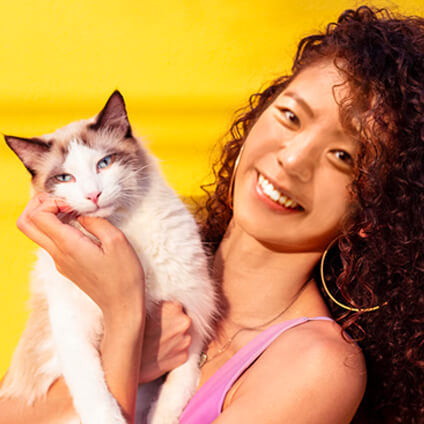
With over five years of specialized experience as an animal writer, my expertise lies in cat nutrition, health, behavior, grooming, and training. I am dedicated to delivering helpful and informative content that caters to the well-being of our feline friends. My primary goal is to empower pet owners with knowledge and ensure our feline companions thrive in health and happiness. In my free time, I love volunteering at local cat rescue centers.
